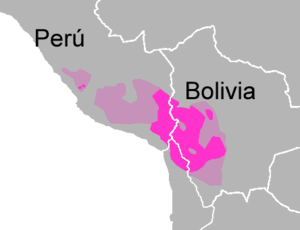Aymaran languages
Aymaran (also Jaqi, Aru, Jaqui, Aimara, Haki) is one of the two dominant language families of the central Andes, along with Quechuan.
| Aymaran | |
|---|---|
| Jaqi, Aru | |
| Geographic distribution | Central South America, Andes Mountains |
| Linguistic classification | Quechumaran?
|
| Subdivisions | |
| Glottolog | ayma1253[1] |
 Dark color: current extent of Aymaran languages. Light color: former extent, as evidenced by toponomy. | |
Hardman (1978) proposed the name Jaqi for the family of languages (1978), Alfredo Torero Aru 'to speak', and Rodolfo Cerrón Palomino Aymaran, with two branches, Southern (or Altiplano) Aymaran and Central Aymaran (Jaqaru and Kawki).
Quechuan languages, especially those of the south, share a large amount of vocabulary with Aymara, and the languages have often been grouped together as Quechumaran. This proposal is controversial, however; the shared vocabulary may be better explained as intensive borrowing due to long-term contact.
Language contact
Jolkesky (2016) notes that there are lexical similarities with the Kechua, Kunza, Leko, Uru-Chipaya, Arawak, and Pukina language families due to contact.[2]
Phonology
Vowels
Aymaran languages have only three phonemic vowels /a i u/, which in most varieties of Aymara and Jaqaru are distinguished by length. Length is commonly transcribed using diaereses in Aymara and length diacritics in Jaqaru.
Consonants
Though Aymaran languages vary in terms of consonant inventories, they have several features in common. Aymara and Jaqaru both contain phonemic stops at labial, alveolar, palatal, velar and uvular points of articulation. Stops are distinguished by ejective and aspirated features. Both also contain alveolar, palatal, and velar fricatives and several central and lateral approximants.
Morphophonology
Aymaran languages differ from Quechuan languages in that all verbal and nominal roots must end in a vowel, even in loanwords: Spanish habas ("beans") became Aymara hawasa and Jaqaru háwaša. This feature is not found in other Andean language.
Like Quechuan languages, Aymaran languages are highly agglutinative. However, they differ in that many agglutinative suffixes trigger vowel suppression in the preceding roots. An example is the loss of final vowel in the word apa ("to take"), when it becomes ap-su ("to take out"). [3]
Family division
Aymaran consists of two languages:
- Aymara. Southern and Central dialects divergent and sometimes considered separate languages.
- Jaqaru (Haqearu, Haqaru, Haq'aru, Aru). Kawki dialect (Cauqui, Cachuy) is divergent.
Aymara has approximately 2.2 million speakers; 1.7 million in Bolivia, 350,000 in Peru, and the rest in Chile and Argentina. Jaqaru has approximately 725 speakers in central Peru, and Kawki had 9 surviving speakers as of 2005. Kawki is little documented though its relationship with Jaqaru is extremely close. Initially, they were considered by Martha Hardman (on very limited data at the time) to be different languages, but all subsequent fieldwork and research has contradicted that and demonstrated that they are mutually intelligible but divergent dialects of a single language.
See also
Bibliography
| Aymara edition of Wikipedia, the free encyclopedia |
- Adelaar, Willem F. H.; & Muysken, Pieter C. (2004). The languages of the Andes. Cambridge language surveys. Cambridge University Press.
- Campbell, Lyle. (1997). American Indian languages: The historical linguistics of Native America. New York: Oxford University Press. ISBN 0-19-509427-1.
- Kaufman, Terrence. (1994). The native languages of South America. In C. Mosley & R. E. Asher (Eds.), Atlas of the world's languages (pp. 46–76). London: Routledge.
References
- Hammarström, Harald; Forkel, Robert; Haspelmath, Martin, eds. (2017). "Aymaran". Glottolog 3.0. Jena, Germany: Max Planck Institute for the Science of Human History.
- Jolkesky, Marcelo Pinho de Valhery (2016). Estudo arqueo-ecolinguístico das terras tropicais sul-americanas (Ph.D. dissertation) (2 ed.). Brasília: University of Brasília.
- Adelaar, Willem F. H. (2004-06-10). The Languages of the Andes. Cambridge University Press. ISBN 9781139451123.